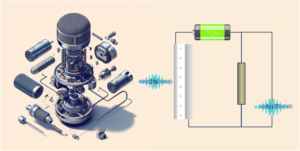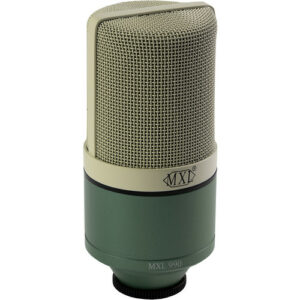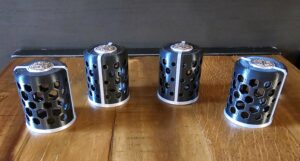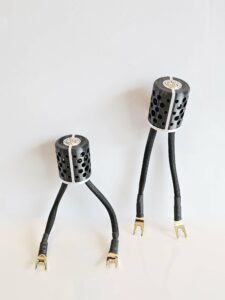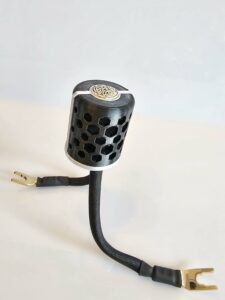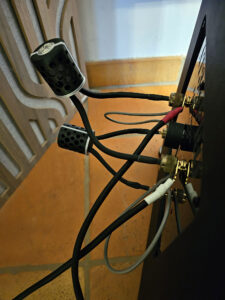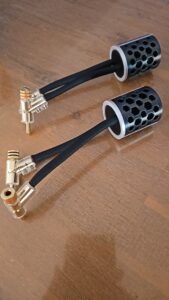Shëol are sneaky devices to be placed behind your speakers, whose duty is to cancel out-of-phase noise from entering your signal.
Concept
Sound is basically about air vibration. The louder the more. The lower the frequencies (basses), the more energy. You can feel it when sitting on your coach. Even at low volume, you can fill with your palm, your body, your stomach that air is moving, even through you. This naturally applies to everything in your room, including your speakers themselves. Damn it ! How ? Through the ground, but also through air smashing surfaces. So spikes will not save you fully…
The in-famous piezoelectric effect
This may sound weird or fake, but is simply very basic, and even part of standard appliances all around you. Pressure sensors for weather for instance are basically metal plates. Air pressure on it changes its resistance, and is easily measurable. A delta of pressure implies a delta of resistance… you convert, and you get the value. Even tiny changes in atmospheric pressure have a measurable impact. And if some current goes through that plate, its shape is altered in an homothetic manner by the input wave. So to simplify… the external signal gets internal (embedded).
This principle is highly welcome in capacitor (condenser) microphones – the graal for professional singers. They sing in front the “plate” (effectively two plates with an insulator in between, within a high current field to capture tiny details) and their voice is transferred with high fidelity to the recorder ! Wonderful. It really is.
Design
Shëol is an electro-acoustic noise canceller to be placed behind your speakers, directly on the bindports (either through spades or bananas depending on your need). As such, it runs in parallel to your cables & speaker.
Its action is based on the retro-action from a capacitor microphone. Out-of-phase air waves stimulate enclosed capacitor, while connected signal irrigates its metallic frame with in-phase signal. Cancellation occurs within its body. As illustrated here, it’s about Eole (air) vs Zeus (electricity)…
Shëol look gives back credit to condenser microphones. We however had to tune a couple of things , like holes/openings sizes depending on the frequencies we are hunting.
Benefits
You get instantly :
- dazzling details on all bandwidth
- wonderland dynamics
- relief & depth
- free your treble
- carnal & intimate medium & voices
- bass punch & matter
- soundstage opening
Obviously, the effect is more audible as air pressure is high near your speakers (side & back walls relative proximity).
Even non audiophile listeners asked to put back Shëols after a couple of seconds. Naturally, we know how demonstrative effects can lure people. This is not the case here.
Please note that Shëol effect can be felt with some similarity to Geysirs & Maskhals as we advise to set them on the speaker bindports back-plate. Effects are smooth & cumulative.
Etymology
Shëol is taken from Hebrew esoterism. As always, many interpretations exist – from the land of Nihil (nothing), to the shores of Death… Take it as a non-return place for condamned out-of-phase waves !
How to use ?
Simply plug Shëol behind your speaker, on top of your usual cable. Keeping its “can” up is not required. Some report horizontal use benefits. Keep it at bindposts heights and in between, nonetheless.
Shëol is provided with spades as this is the typical “free” connection behind your speakers, as people generally use bananas. It is possible to require it in “bananas” version. There is no polarity.
When using multiple posts with straps, it is advise to cross-connect. One connection to positive HF post for instance, the other to LF negative post. If possible, it even goes further to use 2 Shëol per 2-posts speakers. Even with straps, and even further when bi-wiring.
Testimonies
🎤It’s starting to take shape in earnest and… Indeed, the contribution of the Sheöl is truly manifested. In fact, when I take them off, I may feel like the soundstage and timbres are more generous but it’s “mushy” and messier. In short, less finesse and precision in the details, especially the sound nuances, which stand out much better and with more subtlety with the Shéöl. They bring an extra soul to the music. The soundstage is more beautiful, too! Congratulations to you!
*
* *
🎤Well, since some elements are seriously starting to break in, I did a comparison again with and without the Sheöl and I confirm that… I’d have a hard time living without it from now on! Here, the contrast was rather striking! What a life in terms of sound! Sumptuous! Of course, without them, the soundstage may seem more “comfortable” but it seems very soft and confusing in terms of definition. Not to mention the loss of nuance and fineness



